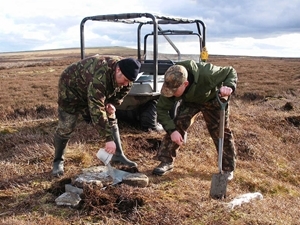 The presence of Trichostrongylus tenuis, a parasitic strongyle threadworm, which lives in the guts of red grouse has been known for more than 100 years. Its impact on red grouse is often referred to as the disease strongylosis. Research started in the 1980s by the GWCT established that infection with strongyle worms can cause 4-6 year cyclical fluctuations in grouse numbers.
The presence of Trichostrongylus tenuis, a parasitic strongyle threadworm, which lives in the guts of red grouse has been known for more than 100 years. Its impact on red grouse is often referred to as the disease strongylosis. Research started in the 1980s by the GWCT established that infection with strongyle worms can cause 4-6 year cyclical fluctuations in grouse numbers.
Once we established the impact of worms on grouse survival and breeding success, our research focused on ways of reducing that impact. In doing so, we have helped reduce the severity and frequency of cyclical grouse population crashes, resulting in greater stabilization of grouse numbers, which in turn has increased the likelihood of shooting.
Contents
Medicated grit
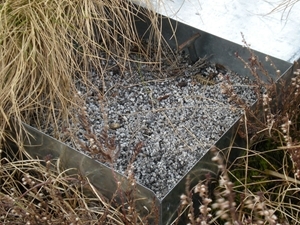 Medicated grit was first developed in the 1980s by the Strathclyde Chemical Company. The original drug used in medicated grit was fenbendazole, part of the benzimidazole group of drugs, sold by Hoechst Animal Health under the trade name of Panacur. The benzimidazole group of drugs are ideal because they are not soluble in water, do not break down in sunlight and work well as a drug taken in split doses. Split dose drugs work by allowing the animal to take in small amounts of the anthelmintic over a period of days, which then accumulates in the body and kills the strongyle worms.
Medicated grit was first developed in the 1980s by the Strathclyde Chemical Company. The original drug used in medicated grit was fenbendazole, part of the benzimidazole group of drugs, sold by Hoechst Animal Health under the trade name of Panacur. The benzimidazole group of drugs are ideal because they are not soluble in water, do not break down in sunlight and work well as a drug taken in split doses. Split dose drugs work by allowing the animal to take in small amounts of the anthelmintic over a period of days, which then accumulates in the body and kills the strongyle worms.
Medicated grit is only available under licence. A veterinarian prescription is now required before purchasing medicated grit from the manufacturers. Evidence of high strongyle burdens in grouse will be required by the veterinarian before they can dispense the appropriate prescription.
Original medicated grit
Early experiments by the Trust showed that this type of medicated grit was associated with an average 44% reduction in worm burdens in grouse and an increased grouse productivity of 40%, the latter largely through improving chick survival. Reducing parasites helps to improve body condition in adult grouse and also reduces their scent emission, making the birds less vulnerable to mammalian predators when breeding.
New medicated grit
In 2007, an improved form of medicated grit was developed. This involved a change in the drug used from fenbendazole to flubendazole; still part of the benzimidazole family of drugs, but one licensed for use in game birds. Simultaneously, the fat was also changed from one that had a temperature-based melting or slip point to a stable non-slip fat. This lengthened drug persistency on the grit instead of slipping-off when temperatures reached those typical of late-spring.
This temperature-resistant persistency brought a new problem. To comply with the law, the medicated grit containing the drug has to be withdrawn from grouse 28 days before grouse are harvested and consumed as food. To do this, the new medicated grit was placed in a box with a lid, which could be closed to prevent access by grouse before and during the shooting season.
Subsequent use of medicated grit has increased markedly so that after 2009, the year when those estates not using medicated grit last crashed, virtually all driven grouse moors use it. Parasite-induced population crashes in grouse now seldom occur and generally worm levels have remained very low (see Figures 1 & 2). Increased efficiency and use of medicated grit and the subsequent increases in grouse densities (see Figure 3) may have brought their own problems. These include the greater likelihood of resistance to flubendazole amongst strongyle worms and the density related emergence of further grouse diseases such as respiratory cryptosporidiosis or bulgy-eye.
Figure 1: Average annual worm burden in autumn-shot adult grouse
from between 8-18 sites across northern England, 1991-2014.
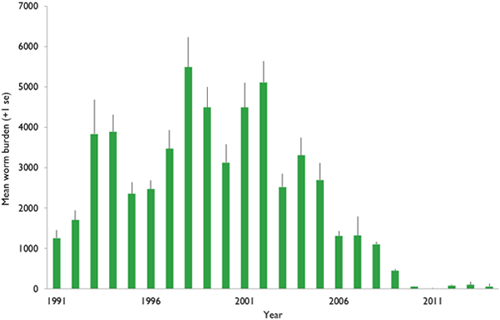
Figure 2: Average density of young and adult red grouse in July
from 25 sites across northern England, 1990-2014.
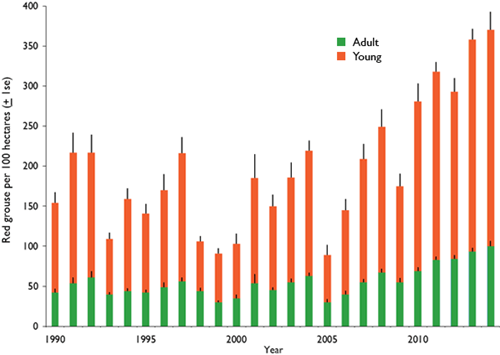
Get your FREE guide on best practice use of medicated grit
Simply enter your email address below to download your free guide.
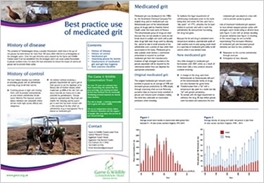 What's inside your FREE guide
What's inside your FREE guide
✓ History of disease
✓ History of control
✓ Medicated grit
✓ Assessing grouse for worms
✓ Deployment of medicated grit and grit box hygiene
✓ Best practice checklist.
*You may change your mind any time. For more information, see our Privacy Policy.